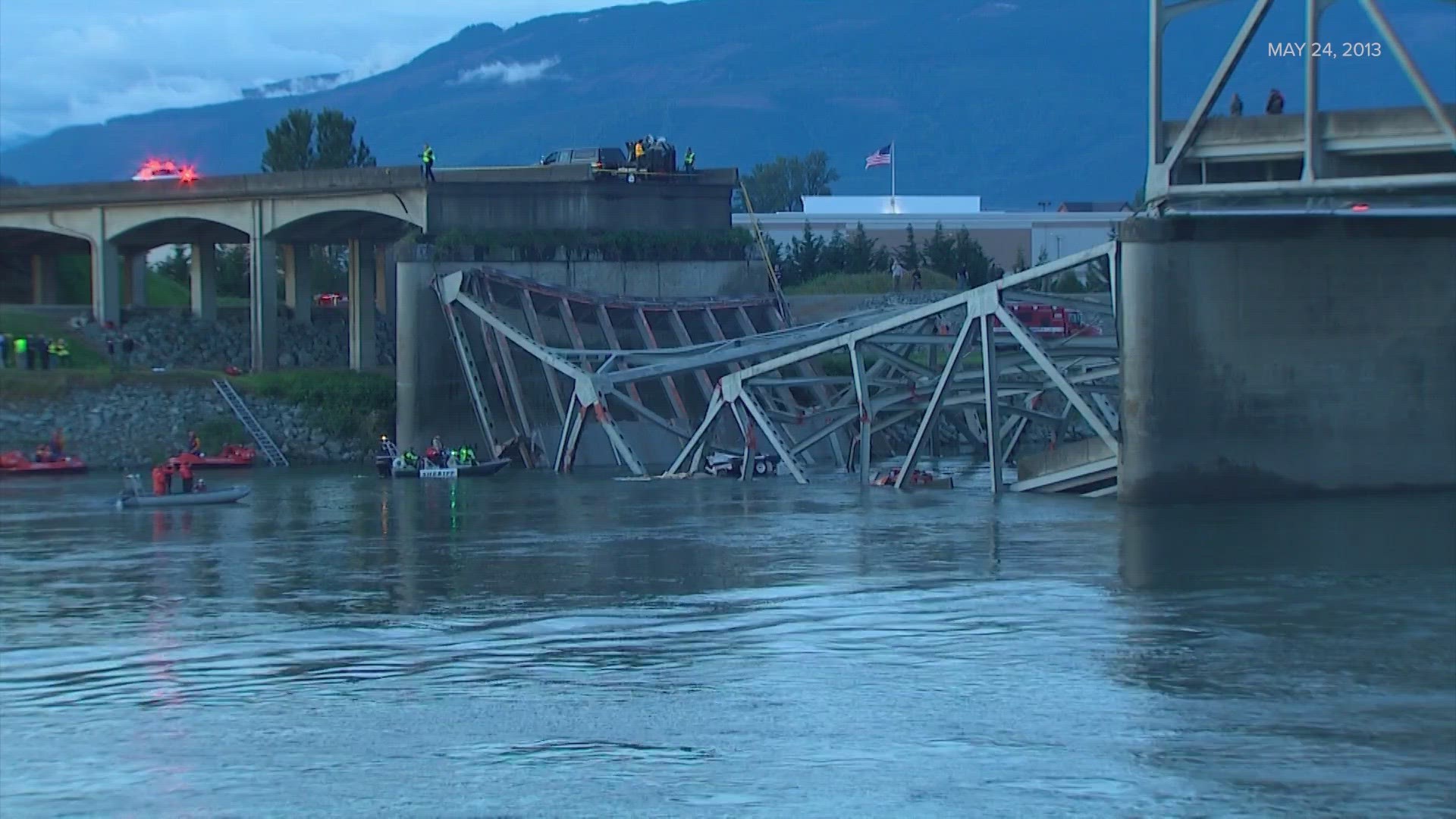MOUNT VERNON, Wash. — It's been 10 years since the Interstate 5 bridge over the Skagit River collapsed, plunging three people and two vehicles into the water below.
A section of the bridge fell into the water on May 23, 2013 after a truck carrying a tall load hit the bridge in Mount Vernon, about 60 miles north of Seattle. Two vehicles fell into the Skagit River and three people were rescued with minor injuries.
Chris Jennings remembers the collapse all too well. He had just left work, driving across the bridge shortly before the incident.
"If I had been at work five more minutes before I left, I very well could have been in that mess," Jennings said.
The collapse investigation
A year after the bridge collapse, the National Transportation Safety Board (NTSB) said insufficient route planning, a distracted pilot driver and an inadequate permitting process by the state of Washington all played a part in the bridge collapse.
William Scott, who was driving the truck with the tall load for Mullen Trucking, told investigators a freight truck came up fast on his left. He said he drove to the bridge's right side, which had a lower vertical clearance than the center lane.
According to the investigation, Scott thought his load was 15 feet and 9 inches - about 2 inches shorter than it actually was. The top of the load collided with the far right side of the overhead truss structure.
The Washington State Patrol Major Accident Investigative Team cited the truck driver for negligent driving, stating the bridge collapse resulted from a series of miscalculations, mistakes and errors by the truck driver and his employer, including:
- The truck driver did not know the accurate height of his oversized load and received a permit for a load 2 inches lower than the one he carried.
- The truck driver failed to research the route to ensure it could accommodate his over-height load. Had he taken the advanced safety steps required of all drivers who haul oversized loads, he would have known the left southbound lane of the bridge provided adequate vertical clearance for the load.
- The pilot-car driver was on the phone as she crossed the bridge and did not notify the truck driver of the height clearance pole striking the bridge.
- The truck driver was following the pilot car too closely and would not have been able to stop in time even if the pilot-car driver had notified him of the pole strikes.
Scott was issued a $550 ticket in May 2014 for his role in the bridge collapse. The Washington Department of Transportation (WSDOT) said the owner of the shed that struck the bridge, Saxon Energy Services, Inc. was also financially responsible for the damage caused by this collision, according to state law.
The aftermath of the collapse
The state Department of Transportation automatically issued Mullen Trucking an oversized-load permit over the Internet, without personnel review and without comparing the given dimensions to the proposed route.
In a 2014 hearing, the NTSB voted unanimously to issue a number of recommendations, including encouraging states to ban nonessential cellphone use by pilot-car drivers and requiring better warnings of low-clearance bridges, as well as lane-specific guidance for bridge clearance.
WSDOT filed a $17 million lawsuit to recover costs related to the bridge collapse. The lawsuit named four parties as responsible: the truck driver whose oversized truck hit the bridge; the driver's employer; the pilot-car driver; and the owner of the metal shed being transported.
Mullen Trucking countersued, saying the state was partially at fault and should have to pay some of the damages. Mullen Trucking said the state was negligent in issuing a permit for the load and in maintaining the bridge.
Two years later, Washington's Supreme Court said in a split decision that the state cannot be held at fault for the accident that caused the I-5 bridge over the Skagit River to collapse in 2013.
In a 5-4 decision, the court pointed to a state law that says vehicle owners or operators must exercise due care in making sure their vehicles can pass under a structure and that the state can't be held liable for damages caused by an over-height vehicle.
The dissenting justices said the state could not be found liable under that law, but that it still could be at fault if it failed to properly maintain the bridge.
The Skagit bridge carries an average of 71,000 vehicles a day over the river on I-5, Washington's major north-south roadway between Oregon and Canada. Workers installed an emergency span and then replaced it with a permanent one in September 2013.
The state is retrofitting old truss bridges to allow for oversized trucks. Bridge and Structure Engineer for WSDOT Evan Grimm said there needs to be better investment in bridge preservation, but, ultimately, the state's bridges are safe.

